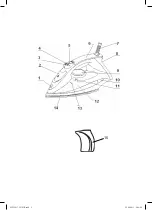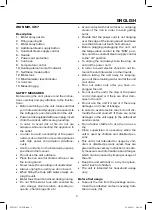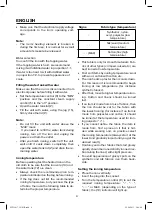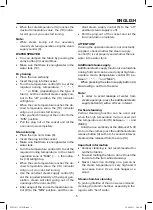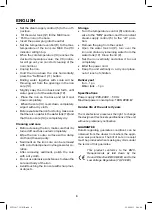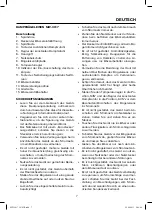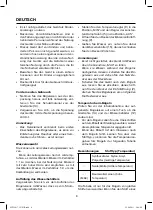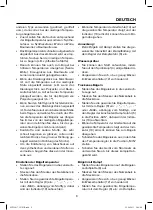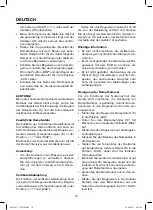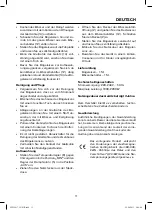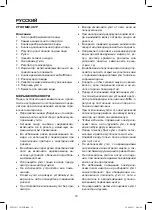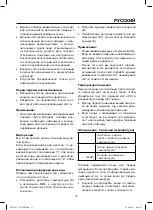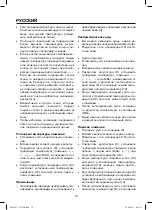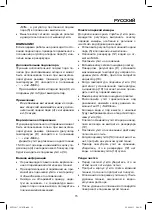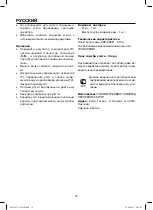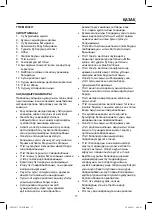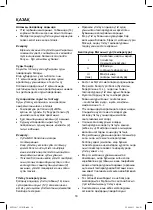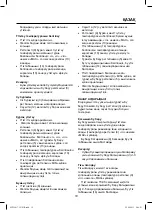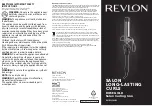
ENGLISH
4
Make sure that the electrical supply voltage
•
corresponds to the iron
’
s operating volt-
age.
Note:
- The iron’s heating element is broken in
during the first use; it is normal for a small
amount of smoke to be released.
Water selection
You can fill the iron with the tapping water.
If the tapping water is hard, we recommend
mixing it with distilled water in proportion 1:1,
if water is too hard mix it with distilled water
in proportion 1:2, to prevent appearance of
scale.
Filling the water tank with water
Make sure that the iron is disconnected from
electrical power before filling it with water.
Set the temperature control (9) to the “MIN”
•
position and the constant steam supply
control (5) to the “off” position.
Open the water tank lid (2).
•
Fill the unit with water, using the jug (15),
•
firmly close the lid (2).
Note:
- Do not fill the unit with water above the
“MAX” mark.
- If you need to refill the water tank during
ironing, turn off the iron and unplug the
power cord from the outlet.
- After you finish ironing, switch off the unit,
wait until it cools down completely, then
open the water tank lid (2) and drain the re-
maining water.
Ironing temperature
Before operating test the heated iron on the
old cloth to be sure that the iron sole (14) and
the water tank (12) are clean.
Always check the recommended iron tem-
•
perature indicated on the tag before ironing.
If the tag does not list the recommended
•
ironing temperature, but you know the type
of fabric, then use the following table to de-
termine the proper temperature.
Signs Fabric type (temperature)
•
Synthetics, nylon,
acryl, polyester (low
temperature)
••
Silk/wool (medium
temperature)
••• (MAX)
Cotton/flax (high
temperature)
This table is only for smooth materials. Fab-
•
rics of other types (crimped, raised etc.) are
best ironed at low temperature.
First sort items by ironing temperature: wool
•
with wool, cotton with cotton etc.
The iron heats up faster than is cools down.
•
For this reason it is recommended to begin
ironing at low temperature (for instance
synthetic fabrics).
After that, move to higher temperature iron-
•
ing. Cotton and linens should be ironed
last.
If an item is made from a mix of fabrics, then
•
the iron should be set for the fabric with
the lowest ironing (for instance if an item is
made from polyester and cotton, it should
be ironed at the temperature used for iron-
ing polyester “
•
”).
If you cannot define the fabric the item is
•
made from, find a place on it that is hid-
den while wearing and, on practice select
the ironing temperature (always start at the
lowest and gradually raise it until you get the
desired result.).
Corduroy and other fabrics that start glossy
•
quickly should be ironed strictly in one direc-
tion (along the lines) with slight pressure.
To avoid appearance of glossy spots on the
•
synthetic and silk fabrics, iron them back-
side.
Setting the ironing temperature
Place the iron vertically.
•
Insert the plug into the socket.
•
Turn the temperature control (9) to set the
•
required ironing temperature: “•”, “••”,
“•••” or MAX,
(
depending on the type of
fabric
), the (10) indicator will light up
.
MW-3017_INSTR.indd 4
MW-3017_INSTR.indd 4
29.06.2011 9:46:00
29.06.2011 9:46:00


